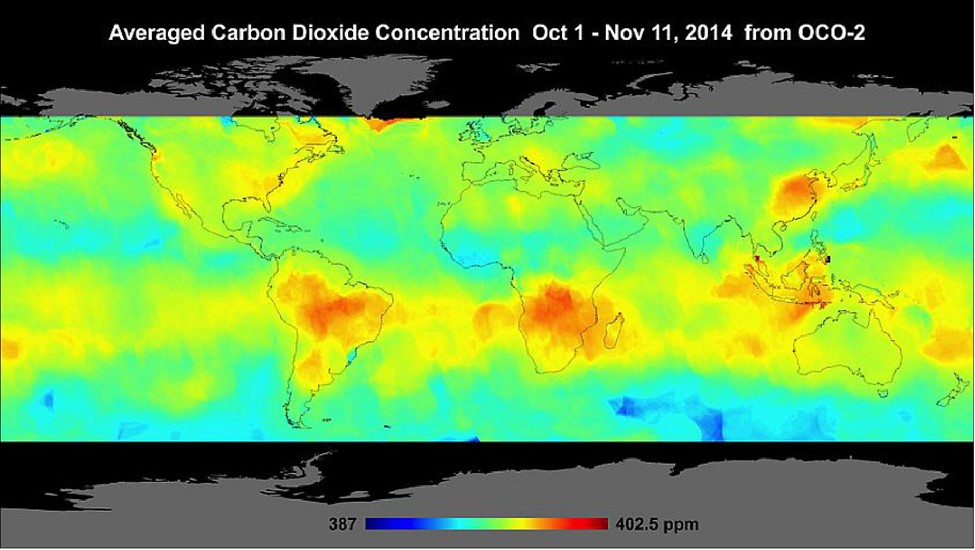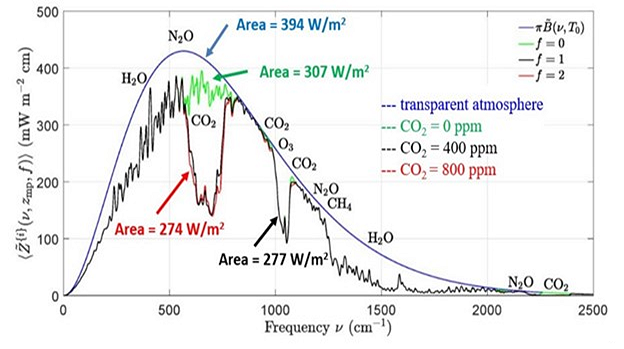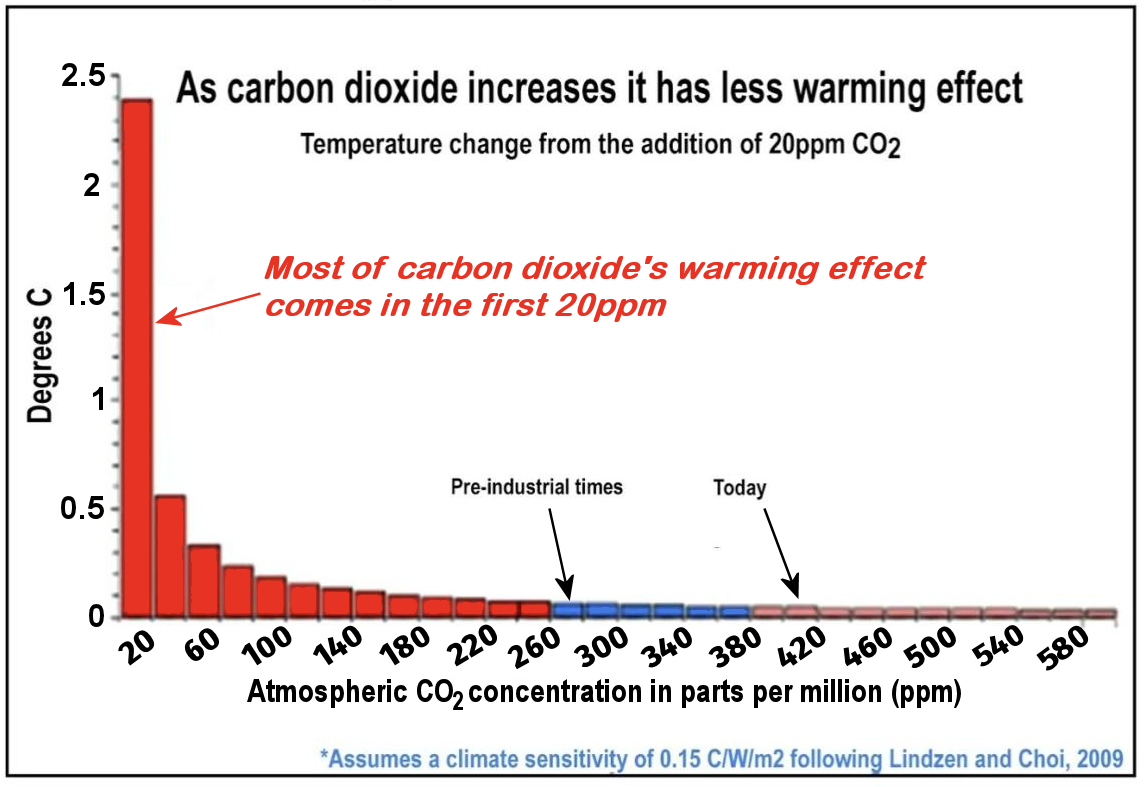Image: Global atmospheric CO2 concentration as recorded by NASA’s OCO-2 satellite mission. Image credit: NASA/JPL-Caltech
Key Takeaways:
- Adding more carbon dioxide (CO2) to the atmosphere will have virtually no additional impact on planetary temperatures.
- CO2 can absorb longwave radiation, which translates to retained warmth in only certain parts of the atmospheric spectrum and in finite amounts.
- Atmospheric CO2 has already reached 99 percent of its potential saturation level for absorbing warmth.
- More CO2 in the atmosphere will have virtually no impact on future temperatures, as near-saturation for absorbing warmth has already occurred.
- Restricting or phasing out conventional energy will do nothing for global temperatures and is scientifically pointless.
Short Summary:
There are many greenhouse gases in Earth’s atmosphere, of which water vapor is by far the most prevalent and powerful. CO2 is a trace gas comprising just four parts per 10,000 of Earth’s atmosphere, up from three parts per 10,000 a century ago. The ability of CO2 to “trap” heat is limited and reaches 99 percent of its potential at four parts per 10,000. Recent research suggests, in fact, that CO2 is already fully saturated, with additional CO2 having a minimal effect at present levels.1 As a result, fretting over new coal or natural gas power plants or any other sources of new CO2 emissions is pointless from a climate perspective.
The chart below is produced by Dr. Will Happer, professor emeritus at Princeton University, and Dr. Richard Lindzen, professor emeritus at Massachusetts Institute of Technology (MIT). Happer and Lindzen are quite possibly the two most expert atmospheric physicists in the world. The chart illustrates how CO2 has already reached its near totality of heat-trapping potential.2

Figure 1: A graph of transparency of the atmosphere with three different concentrations of carbon dioxide. Source: W. Happer and R. Lindzen, “Comment and Declaration on the SEC’s Proposed Rule “The Enhancement and Standardization of Climate-Related Disclosures for Investors,” File No. S7-10-22, 87 Fed. Reg. 21334 (April 11,2022)
The smoothly curved blue line is the amount of heat that would radiate back into space if Earth’s atmosphere had no greenhouse gases. The jagged black line shows how much heat is radiated into space under current greenhouse gas concentrations. The jagged green line shows how much and in which spectrums heat would radiate into space if there were no CO2 in the atmosphere. The jagged red line shows how much heat would radiate into space under a doubling of CO2 compared to present levels. The difference between the black line and the red line is how much additional radiation would be trapped if CO2 concentrations double from present values. As shown by the chart, that difference is miniscule and would impact global temperatures by an imperceptibly small amount.
This concept is illustrated in a simpler way in Figure 2 below.

Figure 2: Atmospheric carbon dioxide saturation versus temperature increase, based on data from Lindzen and Choi, 20093. Note that CO2 becomes less and less effective (at a logarithmic rate) as its atmospheric concentration increases. Thus, there is limited opportunity for additional CO2 to cause heating.
In short, adding more CO2 to the atmosphere will have essentially no impact on global temperatures.
References:
- J. Kubicki, et al., “Climatic consequences of the process of saturation of radiation absorption in gases,” Applications in Engineering Science, March 2024, accessed November 5, 2024; https://www.sciencedirect.com/science/article/pii/S2666496823000456?via%3Dihub
- William Happer and Richard Lindzen, “Comment and Declaration on the SEC’s Proposed Rule “The Enhancement and Standardization of Climate-Related Disclosures for Investors,” File No. S7-10-22, 87 Fed. Reg. 21334 (April 11,2022,)accessed November 5, 2024; https://www.sec.gov/comments/s7-10-22/s71022-20132171-302668.pdf
- Richard S. Lindzen and Yong-Sang Choi, “On the determination of climate feedbacks from ERBE data,” Geophysical Research Letters, 26 August 2009, accessed November 6, 2024; https://doi.org/10.1029/2009GL039628
Climate At A Glance is a Project of The Heartland Institute
View this page as a (PDF) here
Email think@heartland.org
Image: Global atmospheric CO2 concentration as recorded by NASA’s OCO-2 satellite mission. Image credit: NASA/JPL-Caltech
Key Takeaways:
- Adding more carbon dioxide (CO2) to the atmosphere will have virtually no additional impact on planetary temperatures.
- CO2 can absorb longwave radiation, which translates to retained warmth in only certain parts of the atmospheric spectrum and in finite amounts.
- Atmospheric CO2 has already reached 99 percent of its potential saturation level for absorbing warmth.
- More CO2 in the atmosphere will have virtually no impact on future temperatures, as near-saturation for absorbing warmth has already occurred.
- Restricting or phasing out conventional energy will do nothing for global temperatures and is scientifically pointless.
Short Summary:
There are many greenhouse gases in Earth’s atmosphere, of which water vapor is by far the most prevalent and powerful. CO2 is a trace gas comprising just four parts per 10,000 of Earth’s atmosphere, up from three parts per 10,000 a century ago. The ability of CO2 to “trap” heat is limited and reaches 99 percent of its potential at four parts per 10,000. Recent research suggests, in fact, that CO2 is already fully saturated, with additional CO2 having a minimal effect at present levels.1 As a result, fretting over new coal or natural gas power plants or any other sources of new CO2 emissions is pointless from a climate perspective.
The chart below is produced by Dr. Will Happer, professor emeritus at Princeton University, and Dr. Richard Lindzen, professor emeritus at Massachusetts Institute of Technology (MIT). Happer and Lindzen are quite possibly the two most expert atmospheric physicists in the world. The chart illustrates how CO2 has already reached its near totality of heat-trapping potential.2

Figure 1: A graph of transparency of the atmosphere with three different concentrations of carbon dioxide. Source: W. Happer and R. Lindzen, “Comment and Declaration on the SEC’s Proposed Rule “The Enhancement and Standardization of Climate-Related Disclosures for Investors,” File No. S7-10-22, 87 Fed. Reg. 21334 (April 11,2022)
The smoothly curved blue line is the amount of heat that would radiate back into space if Earth’s atmosphere had no greenhouse gases. The jagged black line shows how much heat is radiated into space under current greenhouse gas concentrations. The jagged green line shows how much and in which spectrums heat would radiate into space if there were no CO2 in the atmosphere. The jagged red line shows how much heat would radiate into space under a doubling of CO2 compared to present levels. The difference between the black line and the red line is how much additional radiation would be trapped if CO2 concentrations double from present values. As shown by the chart, that difference is miniscule and would impact global temperatures by an imperceptibly small amount.
This concept is illustrated in a simpler way in Figure 2 below.

Figure 2: Atmospheric carbon dioxide saturation versus temperature increase, based on data from Lindzen and Choi, 20093. Note that CO2 becomes less and less effective (at a logarithmic rate) as its atmospheric concentration increases. Thus, there is limited opportunity for additional CO2 to cause heating.
In short, adding more CO2 to the atmosphere will have essentially no impact on global temperatures.
References:
- J. Kubicki, et al., “Climatic consequences of the process of saturation of radiation absorption in gases,” Applications in Engineering Science, March 2024, accessed November 5, 2024; https://www.sciencedirect.com/science/article/pii/S2666496823000456?via%3Dihub
- William Happer and Richard Lindzen, “Comment and Declaration on the SEC’s Proposed Rule “The Enhancement and Standardization of Climate-Related Disclosures for Investors,” File No. S7-10-22, 87 Fed. Reg. 21334 (April 11,2022,)accessed November 5, 2024; https://www.sec.gov/comments/s7-10-22/s71022-20132171-302668.pdf
- Richard S. Lindzen and Yong-Sang Choi, “On the determination of climate feedbacks from ERBE data,” Geophysical Research Letters, 26 August 2009, accessed November 6, 2024; https://doi.org/10.1029/2009GL039628
Climate At A Glance is a Project of The Heartland Institute
View this page as a (PDF) here
Email think@heartland.org




